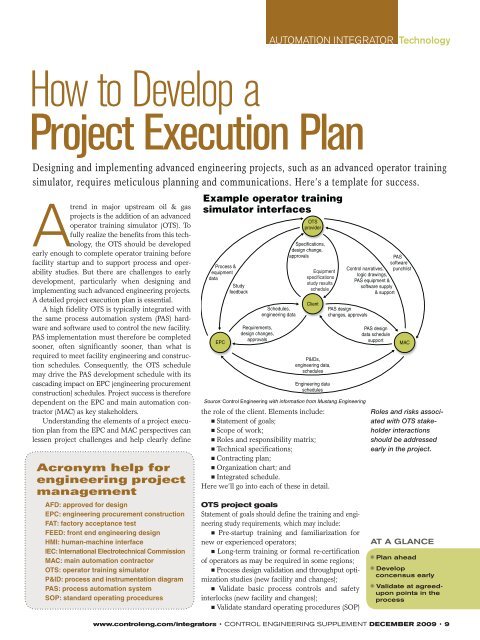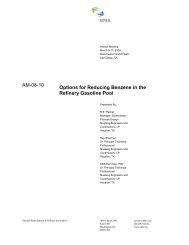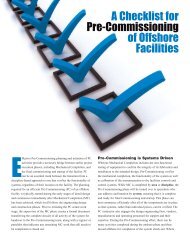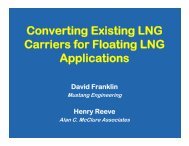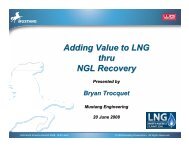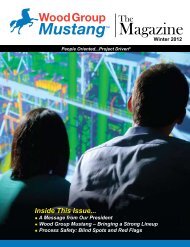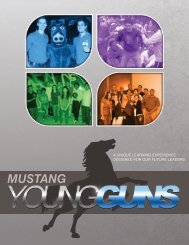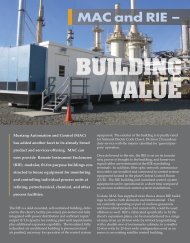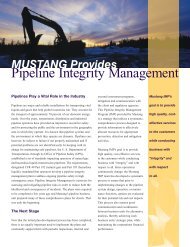How to Develop a Project Execution Plan - Mustang Engineering
How to Develop a Project Execution Plan - Mustang Engineering
How to Develop a Project Execution Plan - Mustang Engineering
You also want an ePaper? Increase the reach of your titles
YUMPU automatically turns print PDFs into web optimized ePapers that Google loves.
<strong>How</strong> <strong>to</strong> <strong>Develop</strong> a<br />
<strong>Project</strong> <strong>Execution</strong> <strong>Plan</strong><br />
Designing and implementing advanced engineering projects, such as an advanced opera<strong>to</strong>r training<br />
simula<strong>to</strong>r, requires meticulous planning and communications. Here’s a template for success.<br />
A<br />
trend in major upstream oil & gas<br />
projects is the addition of an advanced<br />
opera<strong>to</strong>r training simula<strong>to</strong>r (OTS). To<br />
fully realize the benefits from this technology,<br />
the OTS should be developed<br />
early enough <strong>to</strong> complete opera<strong>to</strong>r training before<br />
facility startup and <strong>to</strong> support process and operability<br />
studies. But there are challenges <strong>to</strong> early<br />
development, particularly when designing and<br />
implementing such advanced engineering projects.<br />
A detailed project execution plan is essential.<br />
A high fidelity OTS is typically integrated with<br />
the same process au<strong>to</strong>mation system (PAS) hardware<br />
and software used <strong>to</strong> control the new facility.<br />
PAS implementation must therefore be completed<br />
sooner, often significantly sooner, than what is<br />
required <strong>to</strong> meet facility engineering and construction<br />
schedules. Consequently, the OTS schedule<br />
may drive the PAS development schedule with its<br />
cascading impact on EPC (engineering procurement<br />
construction) schedules. <strong>Project</strong> success is therefore<br />
dependent on the EPC and main au<strong>to</strong>mation contrac<strong>to</strong>r<br />
(MAC) as key stakeholders.<br />
Understanding the elements of a project execution<br />
plan from the EPC and MAC perspectives can<br />
lessen project challenges and help clearly define<br />
Acronym help for<br />
engineering project<br />
management<br />
AFD: approved for design<br />
EPC: engineering procurement construction<br />
FAT: fac<strong>to</strong>ry acceptance test<br />
FEED: front end engineering design<br />
HMI: human-machine interface<br />
IEC: International Electrotechnical Commission<br />
MAC: main au<strong>to</strong>mation contrac<strong>to</strong>r<br />
OTS: opera<strong>to</strong>r training simula<strong>to</strong>r<br />
P&ID: process and instrumentation diagram<br />
PAS: process au<strong>to</strong>mation system<br />
SOP: standard operating procedures<br />
Example opera<strong>to</strong>r training<br />
simula<strong>to</strong>r interfaces<br />
Process &<br />
equipment<br />
data<br />
Study<br />
feedback<br />
EPC<br />
Requirements,<br />
design changes,<br />
approvals<br />
Schedules,<br />
engineering data<br />
OTS<br />
provider<br />
Specifications,<br />
design change,<br />
approvals<br />
Client<br />
P&IDs,<br />
engineering data,<br />
schedules<br />
<strong>Engineering</strong> data<br />
schedules<br />
Source: Control <strong>Engineering</strong> with information from <strong>Mustang</strong> <strong>Engineering</strong><br />
the role of the client. Elements include:<br />
n Statement of goals;<br />
n Scope of work;<br />
n Roles and responsibility matrix;<br />
n Technical specifications;<br />
n Contracting plan;<br />
n Organization chart; and<br />
n Integrated schedule.<br />
Here we’ll go in<strong>to</strong> each of these in detail.<br />
Au<strong>to</strong>mAtion integrA<strong>to</strong>r Technology<br />
Equipment<br />
specifications<br />
study results<br />
schedule<br />
OTS project goals<br />
Statement of goals should define the training and engineering<br />
study requirements, which may include:<br />
n Pre-startup training and familiarization for<br />
new or experienced opera<strong>to</strong>rs;<br />
n Long-term training or formal re-certification<br />
of opera<strong>to</strong>rs as may be required in some regions;<br />
n Process design validation and throughput optimization<br />
studies (new facility and changes);<br />
n Validate basic process controls and safety<br />
interlocks (new facility and changes);<br />
n Validate standard operating procedures (SOP)<br />
PAS<br />
software<br />
Control narratives, punchlist<br />
logic drawings,<br />
PAS equipment &<br />
software supply<br />
& support<br />
PAS design<br />
changes, approvals<br />
PAS design<br />
data schedule<br />
support<br />
MAC<br />
Roles and risks associated<br />
with OTS stakeholder<br />
interactions<br />
should be addressed<br />
early in the project.<br />
at a GLaNCE<br />
• <strong>Plan</strong> ahead<br />
• <strong>Develop</strong><br />
concensus early<br />
• Validate at agreedupon<br />
points in the<br />
process<br />
www.controleng.com/integra<strong>to</strong>rs • CONTROL ENGINEERING SUPPLEMENT DECEMBER 2009 • 9
Au<strong>to</strong>mAtion integrA<strong>to</strong>r Technology<br />
Table 1- Roles and responsibility matrix<br />
Index Activity Owner EPC MAC<br />
Phase 2 – Concept phase<br />
1 Define OTS statement of goals R<br />
Phase 3 – Front end engineering design (FEED) phase<br />
OTS<br />
provider<br />
2 <strong>Develop</strong> OTS specification A R C<br />
3 Define engineering study requirements R C C C<br />
4 <strong>Develop</strong> initial OTS execution plan & schedule A/R R/C C<br />
5 Define OTS Scope in EPC & MAC Contracts R C C C<br />
6<br />
7<br />
<strong>Develop</strong> OTS cost estimate for OTS equipment and<br />
provider services<br />
<strong>Develop</strong> cost Estimate for PAS Equipment and Sup-<br />
port Services (EPC, MAC)<br />
Phase 4 – Detailed design, procurement & implementation<br />
R C<br />
A R R C<br />
8 OTS procurement / contracting R C C C<br />
9 OTS kickoff meeting R I I I<br />
10 <strong>Develop</strong> integrated schedule R C C C<br />
11<br />
Update in-house execution plans with agreed OTS<br />
miles<strong>to</strong>ne dates<br />
A R R R<br />
12 Provide facility engineering & process data I R I I<br />
13<br />
Provide packaged equipment control system soft-<br />
ware & data<br />
I R I I<br />
14 Provide PAS equipment & software <strong>to</strong> OTS provider A R C<br />
15 Model development C I R<br />
16<br />
<strong>Develop</strong> facility standard operating procedures<br />
(SOPs)<br />
R C C I<br />
17 Conduct OTS studies I C C R<br />
18<br />
Assess/authorize OTS study-initiated changes<br />
impacting EPC and MAC.<br />
R C C I<br />
19 OTS-PAS Integration & Testing A C R<br />
20<br />
Implement OTS study-initiated & approve changes<br />
<strong>to</strong> facility and PAS designs<br />
A R R I<br />
21 Train OTS trainers R<br />
22 Train opera<strong>to</strong>rs, verify SOPs R/A C/R C C<br />
Phase 5 – Operations & maintenance phase<br />
23 Long term OTS management & support R C C<br />
R- Responsible, A – Approve, C – Consult, I – Inform<br />
and changes; and<br />
n Validate PAS alarm system performance<br />
(alarm floods, alarm masking).<br />
The statement should define the modeled facilities<br />
(new or existing facility or process units), identify<br />
key schedule miles<strong>to</strong>nes and provide an initial<br />
OTS lifecycle plan. The life-cycle plan, covering<br />
pre- and post-facility startup, identifies the source<br />
of project and long-term support funding and the<br />
OTS location, owner and system manager at each<br />
phase. A long-term support and software manage-<br />
ment plan also should be included.<br />
Specifications define technical, equipment, and<br />
study requirements. The contracting strategy should<br />
recognize the unique challenges of the project. A<br />
single OTS provider should be employed <strong>to</strong> reduce<br />
interfaces, improve support, reduce schedule risk,<br />
and standardize on OTS software. The cumulative<br />
costs from all contrac<strong>to</strong>rs should be considered<br />
when selecting the strategy. The OTS execution plan<br />
must <strong>to</strong> be prepared early <strong>to</strong> make it available when<br />
the client’s project team is ready <strong>to</strong> issue proposal<br />
requests and contracts <strong>to</strong> the<br />
10 • DECEMBER 2009 CONTROL ENGINEERING SUPPLEMENT • www.controleng.com/integra<strong>to</strong>rs<br />
EPC(s) and MAC. Vendors<br />
and contrac<strong>to</strong>rs should be<br />
limited <strong>to</strong> those with proven<br />
technical and execution track<br />
records. Risks associated with<br />
stakeholder interfaces and<br />
accelerated schedules should<br />
be addressed early in the project<br />
through the process of risk<br />
minimization.<br />
Scope definition<br />
During scope definition, the client<br />
defines the equipment and<br />
processes <strong>to</strong> be modeled and the<br />
model fidelity requirements. For<br />
oil & gas applications, modeled<br />
areas typically include all major<br />
oil, gas and subsea production<br />
and utility systems. Model<br />
fidelity is typically high (±2%<br />
accuracy from the steady state<br />
design) <strong>to</strong> achieve accurate process<br />
responses and dynamics.<br />
PAS HMI and controls software<br />
is commonly interfaced <strong>to</strong> these<br />
models.<br />
Upstream projects also<br />
commonly employ skidmounted<br />
packaged equipment<br />
supplied with local embedded<br />
control systems provided for<br />
compression, subsea, well<br />
injection and export systems.<br />
This software is also interfaced<br />
<strong>to</strong> OTS models. MAC<br />
support may be needed <strong>to</strong><br />
complete the PAS-OTS interface.<br />
This support can be a<br />
challenge, since peak OTS<br />
support often occurs during<br />
peak PAS activity periods.<br />
Early OTS development<br />
may be required <strong>to</strong> support<br />
process and design validation<br />
studies. Studies may include<br />
validating facility throughput,
operability and PAS display and controls<br />
performance.<br />
OTS boundaries should be clearly<br />
delineated and stakeholder responsibilities<br />
clearly defined. Table 1 is an<br />
example of a roles and responsibilities<br />
matrix. The OTS support plan,<br />
pre- and post-delivery, is fully developed<br />
here so costs can be assessed<br />
and resources and responsibilities<br />
defined.<br />
Schedule development<br />
<strong>Develop</strong>ing an integrated schedule<br />
begins with the client defining when<br />
the OTS must be ready <strong>to</strong> start opera<strong>to</strong>r<br />
training and, if applicable, <strong>to</strong><br />
support OTS studies. Then, the OTS<br />
provider, EPC and MAC each identifies<br />
when required information and<br />
equipment is needed and when deliverables<br />
can be provided. The client<br />
works with all parties <strong>to</strong> facilitate a<br />
mutually agreed schedule. Schedule<br />
risks are shared among parties.<br />
Example timing for EPC, MAC<br />
and third-party deliverables is listed<br />
in Table 2. Example timing for OTS<br />
deliverables are listed in Table 3.<br />
OTS schedule requirements must be included in<br />
the main facility project schedule developed during<br />
front-end engineering design (FEED). Adding<br />
this and the associated new scope <strong>to</strong> the EPC and<br />
MAC schedules after contracts are signed becomes<br />
increasingly difficult, and decreases the likelihood<br />
of project success.<br />
Schedule acceleration is typically required <strong>to</strong><br />
meet agreed delivery dates. Common acceleration<br />
approaches include working tasks in parallel, and<br />
starting OTS and PAS development work before<br />
design documents are available. Both approaches<br />
result in varying degrees of rework, increasing<br />
the EPC’s and MAC’s scope and therefore cost.<br />
Delivering the PAS design six months sooner than<br />
is needed <strong>to</strong> meet the general facility engineering<br />
and construction schedule can trigger significant<br />
acceleration costs. Controlling these costs is a challenge<br />
for all parties.<br />
<strong>Project</strong> realities that can impact the OTS schedule<br />
and completion include:<br />
n Late supply of vendor data and interface<br />
requirements;<br />
n Late access <strong>to</strong> vendor software needed for PAS<br />
interface development, testing and OTS integration;<br />
n Effectiveness and timeliness of contrac<strong>to</strong>r-<strong>to</strong>contrac<strong>to</strong>r<br />
interfaces;<br />
n Client requirements trigger a major effort <strong>to</strong><br />
develop new HMI and control software templates<br />
and standards;<br />
Table 2 – Example timing for EPC and MAC deliverables<br />
EPC & MAC deliverables Deliverable status<br />
n Significant changes in the PAS design basis or<br />
scope during the detailed design phase;<br />
n <strong>Project</strong> adds new work processes or design<br />
requirements (for example, IEC 61511 adds steps<br />
that can lengthen the safety system design and<br />
software development duration); and<br />
n Unplanned cus<strong>to</strong>m emulations are needed,<br />
such as when vendors will not provide proprietary<br />
software or algorithms.<br />
Organizational considerations<br />
<strong>Project</strong> success requires sound organizational and<br />
staffing decisions. Selecting the right person for<br />
the client project manager role is critical. Recommended<br />
skills include basic contract management,<br />
an understanding of interface and schedule<br />
management, good organization and communication<br />
skills and sufficient technical knowledge and<br />
authority <strong>to</strong> respond <strong>to</strong> queries and make timely<br />
decisions. The EPC and MAC should provide an<br />
OTS interface coordina<strong>to</strong>r <strong>to</strong> manage information<br />
exchange requests, attend interface meetings and<br />
coordinate schedules and activities within their<br />
respective organizations.<br />
Risks associated with OTS stakeholder interfaces<br />
should be addressed early in the project. The<br />
“Example interfaces” illustration (on p. 9) shows<br />
some possibilities. The client is typically at the center<br />
of this challenging, multi-organization, interface-intensive<br />
effort. Employing the right people in<br />
Months from start of<br />
detailed design phase<br />
PAS hardware & base software selected Defined in FEED<br />
P&ID, process & equipment data Preliminary 3-10<br />
P&ID, process & equipment data<br />
Approved for design<br />
(AFD)<br />
6-12<br />
Safety logic drawings and control narratives AFD * 6-10<br />
* Up <strong>to</strong> 22 months if dependant on packaged equipment data<br />
Vendor data from long lead 3rd party<br />
package & equipment vendors<br />
** Earlier dates may be required <strong>to</strong> meet OTS schedule<br />
Issue PAS configured I/O,<br />
basic controls and HMI.<br />
Issue PAS complex<br />
controls & software update<br />
Integration <strong>to</strong> control system software<br />
from long lead, 3rd party vendors<br />
AFD **13-22<br />
Fully tested/approved<br />
software templates<br />
Spot test base HMI and<br />
controls software<br />
Full fac<strong>to</strong>ry acceptance<br />
tested (FAT)<br />
15-18<br />
16-22<br />
FAT 16-24<br />
Issue PAS balance of plant software FAT 22-28<br />
Provide PAS equipment<br />
and applications support<br />
As needed Duration<br />
www.controleng.com/integra<strong>to</strong>rs • CONTROL ENGINEERING SUPPLEMENT DECEMBER 2009 • 11
Au<strong>to</strong>mAtion integrA<strong>to</strong>r Technology<br />
key roles provides a means <strong>to</strong> improve<br />
the timeliness and effectiveness of an<br />
interface. Opportunities <strong>to</strong> simplify or<br />
streamline an interface also should be<br />
considered <strong>to</strong> reduce project risk.<br />
Feedback, acceptance tests<br />
Feedback from OTS studies will generate<br />
PAS and facility design changes <strong>to</strong><br />
consider. The client will need a process<br />
<strong>to</strong> manage this work and its potential<br />
impact on cost and schedule. A rigorous<br />
management of change process must<br />
be in place. The change process must<br />
include review, approval, implement,<br />
test, and document work status as it<br />
progresses.<br />
Dividing PAS acceptance tests in<strong>to</strong><br />
multiple test periods <strong>to</strong> support staged software deliveries can<br />
increase PAS scope and cost. Frequent changes and incremental<br />
testing provides the opportunity for software errors <strong>to</strong> creep in.<br />
Both should be addressed in the MAC’s change management and<br />
quality plans.<br />
The client may need <strong>to</strong> exercise corporate agreements <strong>to</strong><br />
ensure third-party vendors release proprietary software, algorithms<br />
or functional design information <strong>to</strong> the OTS provider.<br />
Sample organizational chart<br />
EPC<br />
interface<br />
coordina<strong>to</strong>r<br />
COMPACT<br />
CABINET COOLER<br />
for sealed electrical enclosures<br />
GREAT GREAT FOR FOR<br />
food food processing processing<br />
Client OTS<br />
project<br />
manager<br />
OTS provider<br />
project<br />
manager<br />
SOP’s may need <strong>to</strong> be written earlier<br />
<strong>to</strong> allow time for verification using<br />
the OTS.<br />
A challenge when designing safety<br />
systems <strong>to</strong> IEC 61511 is acquiring<br />
process response times for a new<br />
facility. This data is used <strong>to</strong> set safety<br />
interlock speed of response requirements.<br />
Response data from the OTS<br />
may prove <strong>to</strong> be more accurate than<br />
data derived through other means<br />
and should be explored.<br />
<strong>Plan</strong>, realities,<br />
requirements<br />
Early supply of a high fidelity and<br />
PAS-integrated OTS is possible, but<br />
requires the right execution plan and<br />
aggressive plan execution by all parties. The client OTS project<br />
manager and EPC and MAC coordina<strong>to</strong>rs are key positions that<br />
directly impact project success. Risks should be identified, managed<br />
and, <strong>to</strong> the extent possible, thoughtfully distributed among<br />
OTS contribu<strong>to</strong>rs. <strong>How</strong> early the OTS can be delivered depends<br />
on project specific realities and requirements. ce<br />
Author: Tom Shephard, PMP, CAP, <strong>Mustang</strong> <strong>Engineering</strong>, is a<br />
main au<strong>to</strong>mation contrac<strong>to</strong>r program manager and au<strong>to</strong>mation project<br />
manager.<br />
For more information, visit:<br />
www.mustangeng.com<br />
Table 3 – Example OTS timeline<br />
Event or EPC and<br />
MAC supplied<br />
engineering data<br />
OTS<br />
provider<br />
activity<br />
Months<br />
from<br />
first oil<br />
OTS award 30<br />
P&ID, process and equip-<br />
ment data – preliminary<br />
P&IDs, process and<br />
equipment data – AFD<br />
<strong>Plan</strong>ning,<br />
specifications<br />
29<br />
Model build 28<br />
Model validation,<br />
FEED studies<br />
Detailed engineering<br />
data for model update<br />
26<br />
23<br />
<strong>Engineering</strong> studies 21<br />
Model update 17<br />
PAS delivery PAS integration 16<br />
OTS design & integration<br />
completed<br />
MAC<br />
interface<br />
coordina<strong>to</strong>r<br />
Source: Control <strong>Engineering</strong> with information from <strong>Mustang</strong> <strong>Engineering</strong><br />
<strong>Project</strong> managers for the client and provider interact<br />
with the engineering procurement construction<br />
(EPC) interface coordina<strong>to</strong>r and with the main<br />
au<strong>to</strong>mation contrac<strong>to</strong>r (MAC) coordina<strong>to</strong>r.<br />
REMOVE WASTE HEAT<br />
WHILE KEEPING<br />
CONTAMINANTS OUT<br />
Replaces air conditioning | Replaces<br />
compressed air | Easy installation |<br />
Energy efficient | NEMA 12, 4, 4x |<br />
Stainless Steel | Washdown<br />
norenproducts.com/ccc<br />
650.322.9500<br />
Integrated PAS and<br />
operating procedure<br />
checkout<br />
14<br />
OTS acceptance test 8<br />
Instruc<strong>to</strong>r training,<br />
SOP verification<br />
Opera<strong>to</strong>r training 6<br />
First oil 0<br />
12 • DECEMBER 2009 CONTROL ENGINEERING SUPPLEMENT • www.controleng.com/integra<strong>to</strong>rs<br />
7


